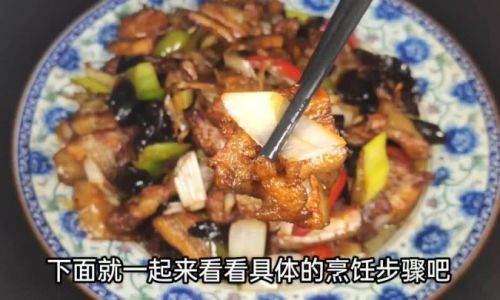Introduction
In the vast culinary landscape of Chinese cuisine, stir-frying stands as a testament to the art of rapid cooking, where the interplay of heat, oil, and ingredients creates dishes that are both visually appealing and bursting with flavor. Among the myriad of stir-fry recipes, “Pork Belly with Scallions” (often referred to as “Cong Bao Rou” in Mandarin) holds a special place. This dish combines the succulence of slow-cooked pork belly with the crisp freshness of scallions, all enveloped in a savory, slightly sweet sauce that dances on the palate. It’s a meal that promises comfort, satisfaction, and a burst of umami in every bite.
In this comprehensive guide, we’ll delve into the intricacies of preparing Pork Belly with Scallions, from selecting the perfect ingredients to mastering the stir-fry technique. By the end, you’ll be equipped with the knowledge and skills to recreate this classic dish in your own kitchen, impressing friends and family with your culinary prowess.
Section 1: Ingredient Selection and Preparation
1 Pork Belly

The cornerstone of this dish is, of course, the pork belly. Look for a piece that has a good balance of fat and lean meat. The fat should be evenly distributed, with a layer that’s not too thick but sufficient to keep the meat moist during cooking. Ideally, choose pork belly that’s been properly aged for optimal flavor and tenderness.
Preparation:
- Trimming: Start by trimming off any excess fat or sinew. Aim for a fat-to-meat ratio that suits your preference, but remember, some fat is crucial for flavor and moisture retention.
- Slicing: Cut the pork belly into thin slices, approximately 1/4 to 1/2 inch thick. Thinner slices will cook faster and become more tender, while thicker slices retain more moisture and have a more substantial bite.
- Marinating: In a bowl, combine the sliced pork belly with a mixture of soy sauce, Shaoxing wine (or dry sherry), a pinch of sugar, and a dash of sesame oil. Let it marinate for at least 30 minutes to an hour, allowing the flavors to penetrate the meat.
2 Scallions
Scallions, also known as green onions, add a fresh, slightly pungent flavor and a crunchy texture to the dish. Choose bunches with bright green stalks and firm, white bulbs. Avoid scallions that are wilted or have yellowing leaves.
Preparation:
- Cleaning: Rinse the scallions thoroughly under cold running water, then shake off excess water.
- Chopping: Cut the scallions into 2-3 inch lengths, keeping the white and green parts separate. The white parts will cook faster and soften, while the green parts retain their crunch and add a vibrant color to the dish.
3 Other Ingredients
- Garlic and Ginger: These aromatics are essential for building the foundation of flavor in the stir-fry. Mince them finely to ensure they release their essence quickly during cooking.
- Oyster Sauce and Soy Sauce: These condiments provide the savory backbone of the sauce. Oyster sauce adds a rich, umami flavor, while soy sauce brings saltiness and depth.
- Shaoxing Wine (or Dry Sherry): Adds a subtle sweetness and complexity to the dish.
- Sugar and Sesame Oil: Sugar balances out the savory flavors and adds a hint of sweetness, while sesame oil enhances the overall aroma.
- Vegetable Oil: For stir-frying, choose a neutral-flavored oil with a high smoking point, such as canola or peanut oil.
Section 2: Cooking Equipment and Techniques
1 Equipment
- Wok or Large Frying Pan: A wok is ideal for stir-frying due to its shape, which allows for even heat distribution and easy tossing of ingredients. However, a large, heavy-bottomed frying pan can also work well.
- Spatula or Wooden Spoon: A spatula with a flat edge is perfect for stirring and tossing ingredients in the wok. A wooden spoon is another traditional option that won’t scratch non-stick surfaces.
- Tongs: Useful for handling hot ingredients without burning your fingers.
- Strainer: For draining excess oil from stir-fried dishes.
2 Techniques
Preheating the Wok/Pan:
Before adding any oil, preheat your wok or frying pan over high heat until it’s very hot. This ensures that the ingredients will sear immediately upon contact, locking in juices and flavors.
Adding Oil:
Pour in just enough oil to coat the bottom of the wok/pan. Swirl it around to ensure even coverage. The oil should be hot but not smoking before adding the ingredients.
Stir-Frying the Aromatics:
Add the minced garlic and ginger to the hot oil. Stir-fry for just a few seconds until fragrant but not burnt. This step is crucial for building the flavor base of the dish.
Cooking the Pork Belly:
Add the marinated pork belly slices to the wok/pan in a single layer, avoiding overcrowding. Stir-fry for about 2-3 minutes on each side, or until they turn golden brown and slightly crispy. The key is to cook them quickly over high heat to retain moisture and avoid overcooking. Remove the pork belly from the wok/pan and set aside.
Stir-Frying the Scallions:
In the same wok/pan, add a bit more oil if needed. Stir-fry the white parts of the scallions first for about 1 minute until they soften. Then, add the green parts and stir-fry for another 30 seconds to 1 minute, until they are just wilted but still crisp.
Combining Ingredients and Sauce:
Return the cooked pork belly to the wok/pan with the scallions. Pour in a mixture of oyster sauce, soy sauce, Shaoxing wine, sugar, and a touch of sesame oil. Stir-fry everything together for another 1-2 minutes, until the sauce thickens slightly and coats the ingredients evenly. Taste and adjust seasoning as needed.
Serving

Transfer the Pork Belly with Scallions to a serving dish, garnishing with a sprinkle of sesame seeds or chopped green onions for added color and flavor. Serve immediately while hot, accompanied by steamed rice or your favorite side dish.
Section 3: Tips and Tricks for Perfection
1 Temperature Control
Maintaining high heat is crucial for stir-frying. This ensures that the ingredients sear quickly, locking in juices and flavors. However, be mindful of not letting the oil smoke excessively, as this can impart a bitter taste to the dish.
2 Don’t Overcrowd the Pan
Overcrowding the wok/pan will lower the temperature and cause the ingredients to steam rather than stir-fry. Work in batches if necessary to ensure even cooking.
3 Marinate for Flavor
Marinating the pork belly not only tenderizes the meat but also allows the flavors of the marinade to penetrate deeply. Don’t skip this step for optimal taste.
4 Balance of Ingredients
The balance between pork belly, scallions, and sauce is key. Too much sauce can make the dish soggy, while too little can leave it dry. Adjust according to your taste preferences.
5 Don’t Overcook
Stir-frying is a quick cooking method. Overcooking will result in dry, tough meat and overcooked scallions. Keep an eye on the clock and the color of the ingredients to ensure they are cooked to perfection.
Conclusion
Pork Belly with Scallions is a dish that embodies the essence of Chinese stir-frying – simple ingredients transformed into something extraordinary through the magic of heat, oil, and timing. By following the steps outlined in this guide, you’ll be able to create a dish that’s not only visually stunning but also bursting with flavors that dance on your palate. Whether you’re a seasoned chef or a home cook eager to impress, this classic recipe promises to deliver satisfaction and delight with every bite. Happy stir-frying!






0 comments